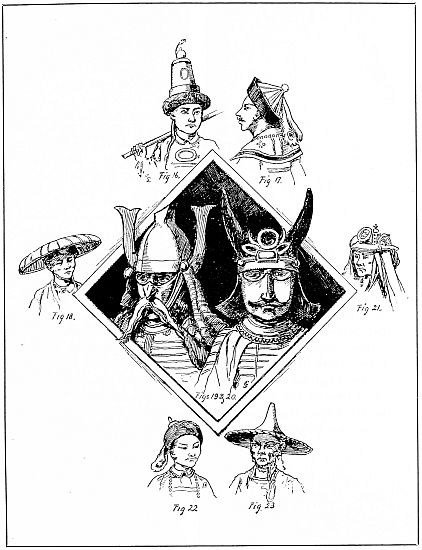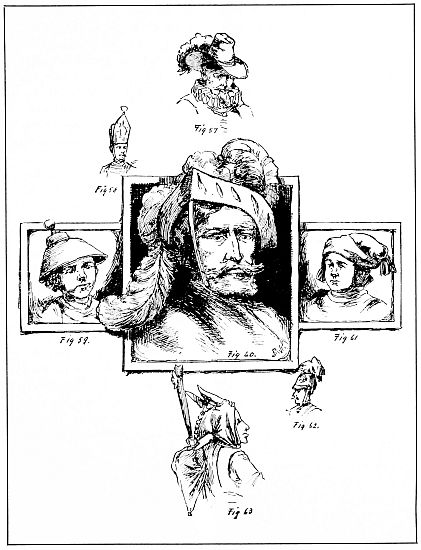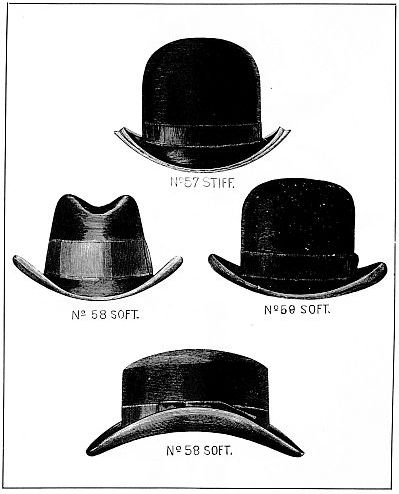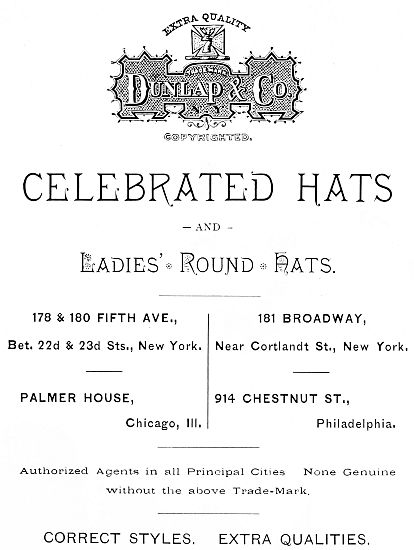Copyrighted, 1885,
By R. DUNLAP & CO.
Lockwood Press, 126 & 128 Duane St., New York.
A SHORT TREATISE
ON
* HEAD * WEAR *
ANCIENT AND MODERN,
ILLUSTRATED BY
Walter H. Goater.
Tracing the history of man as far back as we can under civilized conditions of life, we find that in one form or another he has made use of some artificial contrivance to protect his head.
Nature, in her bounty, seems to have provided in part against the necessity of the hat, by giving to the head a thick and abundant covering of hair, but, instead of considering this as an indication that the head required no other protection, mankind seems rather to have regarded it as a hint to keep this most important part of the body well covered.
The hat being the most conspicuous article of dress, and surmounting all the rest, it is only natural to find that from the earliest times special care and attention has been given to its adornment—showy plumes, rare jewels and rich bands of gold and silver being used at different periods to decorate it.
Its form and frequently its color have also been made to designate the rank and character of the wearer: As the Monarch by his crown, the Cardinal by his red hat, which betokens his readiness to spill his blood at any time for the sake of Christ, and the court fool by his cap with bells. In [3]one form it serves to designate the military officer, in another the peaceful Quaker or the quiet man of letters.
The materials employed in the manufacture of hats have been various, stuffs of every kind and color having entered into their composition. The birds have been robbed of their brilliant plumage, the beasts of the field of their wool and hair. Amphibious creatures have yielded their fur, while the mines of the earth have given up precious metals and stones. All these have been used by man to make a suitable covering for his august head. Felt hats are by far the most ancient, silk hats being of quite recent introduction. They were known in Florence about a century ago, but were not introduced into France until 1825.
Tradition ascribes the discovery of felting to St. Clement. It occurred in this manner: While on one of his charity missions, becoming weary and foot-sore, he took off his sandals to ease his feet, which were all bruised from long walking over rough roads. While resting by the wayside an opportunity was afforded him of rescuing a little lamb from the cruel clutches of a wily fox that was pursuing it. The grateful little creature jumped round him and licked his hand for joy, and it was in fondling it that St. Clement observed some loose wool, which he gathered.
While carelessly handling it the thought suddenly struck him that it would be good to bind up the wounds on his feet with. No sooner was it thought than done, and he found it so soothing that he immediately resumed his journey.
At night when he came to remove his sandals he was surprised to find, instead of fine, soft wool, a piece of cloth, so firm and thick that he could not pull it apart. This was [6]called felt, and St. Clement was made the patron saint of the craft. (However, it is only fair to state that, according to some authorities, there is abundant evidence to show that felting was known to the ancients long before the time of St. Clement or the Christian era.)
The most ancient form of head wear we find to be the cap such as is seen on figures representing the goddess of liberty. Hoods, also, of various shapes, date back long before hats appeared, the latter for a long time only being employed as an article of extra clothing in winter, worn over the hood or when going on a journey.
Among the ancient Egyptians very peculiar shaped caps were worn, like from Figures 1 to 7. Some of them would rise to a great height above the head, and then descend very low upon the chest in the shape of lappets. Those of the priests and of their attendants were often loaded with a profusion of symbolical decorations, composed of feathers, lotus leaves and other natural products.
In religious processions it was common to wear masks that covered the whole head and neck down to the shoulders. These represented the heads and busts of various sacred animals, such as the ibis, hawk, bull, dog and ram.
Our modern hat can be traced back to the pileus worn by the ancient Greeks when on a journey. Hats with brims were also worn by them, though some authorities claim [8]that the Greek citizen of mature years never wore a head-covering, it being confined to youths, workmen and slaves. The pileus was a closely-fitting woolen skull-cap, which was sometimes worn as a lining to the helmet. It was adopted by the Romans at their public games and festivals by those who had once been slaves, and by the aged and infirm for sake of warmth.
From ancient coins and medals we find that the Romans went bareheaded, except at sacred rites, games, festivals, and when at war.
Baldness was looked upon by them as a great deformity, and Cæsar, mighty conqueror though he was, yet could not make nature add one single hair to his very scanty supply, is said to have prized the honor of wearing a laurel crown above all the other dignities conferred upon him by the senate, as it served to conceal his weakness.
In the city, to screen themselves from the heat, rain or wind, the Romans frequently threw the folds of their robe over their heads, but if they met any one to whom they owed respect, they immediately let the folds drop and remained bareheaded.
Figs. 10 and 12 are specimens of ancient Greek helmets, while Fig. 11 represents a young warrior equipped for battle. Fig. 8 shows the petasus, not greatly unlike our tennis hat of to-day. Fig. 14 is the Phrygian bonnet, which held its own for so many centuries.
The inhabitants of Eastern nations always have their heads covered. In China the men wear hats in shape and size resembling large umbrellas, like Figs. 18 and 23, or [10]else small conical caps similar to Fig. 17. These are made of beautifully wrought cane-work and often have pictures of birds and flowers painted upon them. They also have another cap, which though richer in material is not so graceful. It is similar in shape to Fig. 22, made of black velvet with a blue silk centre and a red tassel surmounting the top. The distinctive mark of different ranks among the mandarins consists in the color and value of the button worn on the cap. Figs. 19 and 20 show the peculiar head-dress worn by the Japanese when going forth to battle. In Arabia, notwithstanding the heat of the climate, the men wear a most preposterous head-dress. Frequently fifteen cloth or linen caps are worn one over the other, the upper one being gorgeously embroidered in gold with a sentence from the Koran worked upon it. Not satisfied with this curious coiffure they add to it by wrapping around the outer cap a large piece of muslin ornamented at the ends with silk or golden fringe, which stream loosely on the shoulders.
A plume of white heron’s feathers is the distinctive badge of a chief among the Uzbek Tartars.
Throughout the East the turban is generally worn, its height being a mark to denote the rank of the wearer. In color it is generally of the most brilliant hue, and of richly embroidered materials. Great taste and ingenuity are exercised in the manner of twisting it around the head so as to make the folds appear as graceful as possible. The different turbans on page 9 give some idea of the various shapes they can be made to assume.
Emirs or Sharifs, descendants of Mohammed’s daughter, are alone allowed the high honor of adorning their heads with green turbans.
On page 11 we have some types of African head-dress, Figs. 31, 32 and 34 showing what the natives of that dark continent have done for themselves in the way of head adornment, entirely unaided by fashion or the knowledge of what their brothers in other parts of the world were wearing. Fig. 33, though of Asiatic origin and finer workmanship, is quite as grotesque in design as anything the wild tribes of Africa could devise.
At one time the Turks had a law by which none but themselves could wear turbans of rich texture. Their Greek subjects were condemned to wear dark cotton caps as a mark of their servitude. Armenians were compelled to appear in ridiculous-looking balloon-shaped caps, while the Jews were only permitted to wear brimless caps resembling inverted flower-pots. Later on, the Sultan issued a decree that all of his subjects should wear a red fez instead of their turbans. This law was received with the most determined and indignant opposition. So obnoxious to their feelings was this change, that the discontented party set fire to the houses of all those who favored it, and though finally the Sultan’s wishes passed into a law, it was years before many of his subjects became reconciled to it. Fig. 40 shows a turban worn by one of the Sultans; Fig. 41, the fez of the people. Figs. 37, 38, 42 and 43 on the same page are samples of Russian hats. In some parts of that country the head-covering of the people is made of birch bark and plaited grasses; but fur is the material most commonly used. The prevailing male head-dress of the inhabitants of Asia Minor appears to be the Phrygian bonnet, of which the characteristic features with them are its point on top, bent forward, and its long flaps descending on the shoulders. This style of hat was worn for many centuries, and traveled as far west as Venice, where the Doge always wore one.
As a part of defensive armor the hat became the helmet, which has changed but little in shape from the earliest times. Very elaborate and fantastic were some of the early forms, with their double or two-story heads, Figs. 46 and 47, to give the impression of increased height. The workmanship, also, was very beautiful, some of the ancient helmets being entirely covered with chasing and designs of the most intricate character. With the Greeks and Romans the subject of armor was one of importance, and from their ancient monuments we can learn much of their form and beauty. Page 15 shows several kinds of helmets worn during the middle ages.
In Spain serious disturbances took place in Madrid in the eighteenth century over an attempt being made to banish the sombrero. While in other countries the fashion of hats has been undergoing changes, in Spain the same shapes are worn year after year, with but little modification. Page 19, with the exception of Figs. 52 and 53, which are Mexican, show several forms of Spanish hats. Fig. 51 is the style commonly worn by the priests when traveling about.
Page 21 gives some German types; Fig. 61 is the hat of a judge; Figs. 58, 60 and 62 are military hats, while Fig. 63 shows a Teutonic fool’s cap decorated with bells.
In France the clothing of the head has long been a subject of special consideration, and many have been the styles [16]that have emanated from there. At first, as in most of the other countries mentioned, hoods were worn, but when Charles VII. made his triumphal entry into Rouen, in 1449, he wore a hat lined with red velvet and surmounted with a rich plume of feathers. From this date hats and caps became general throughout France.
A curious appendage that was worn with the hat for many years was like Fig. 66, consisting of a piece of black stuff which was fastened to one side of the hat, the other end being thrown over the left shoulder. This band was often held in the hand and the hat allowed to fall off from the head and rest on the back.
Another peculiar head-dress was the Capuchin hood, Fig. 68. This had a long pointed tail that hung down the back, and in front was buttoned close up to the chin. Some gallants twisted the tails into all sorts of fantastic forms and carelessly poised them on the top of the head. With the shaven faces that were always worn with this hood, the men all looked very much like monks. It was fear of this appearance that induced Francis I. to set the fashion of velvet caps in his kingdom. Fig. 67 represents a French military hat. For the past fifty years the high silk hat has been the most popular style in France.
At one time there was a law in France which compelled all bankrupt Jews to wear a green hat, so that people might avoid losses by trading with them. The slang expression “Do you see anything green about me,” is said to have derived its origin from this circumstance.
The early Anglo-Saxons for years wore no other covering for their heads than their long flowing hair, which they [18]sedulously cultivated. When they did take to a covering, about the eighth century, it was in the form of a cap made most likely from the undressed skin of animals. The Britons, at the time of the invasion of Cæsar, wore on their heads a conical hat, which derived its name from the cabin or hut in which they lived, it strongly resembling it in shape. Helmets, with a projecting piece in front called a nasal, were worn by the early Briton warriors. The nasal was afterward discarded, as it was found to afford too convenient a hold to the enemy of the wearer, Stephen, at the siege of Lincoln, having been seized by the nasal of his helmet and held a prisoner.
It was not until after the Norman conquest that the use of hats became general in England. “A hatte of bever” was worn by some one of the nobles met at Clarendon about the middle of the twelfth century, and in the “Canterbury Tales” we hear mention of the merchant wearing on his head a “Flaunderish bever hat.”
In the fourteenth century we find a very peculiar kind of head-gear popular in England, Figs. 70 and 72. First, on the head is a close-fitting skull-cap, which is encircled by a roll of cloth, flat like a band, or twisted turban-wise. Above is another piece of cloth, cut and clipped around the edges in all manner of queer shapes, the whole falling around the head in a confused manner. Such hoods were worn by the ancient Knights of the Garter, and are said to have been borrowed from Italy.
It is in this same century that for the first time in England we find a feather in the hat, Fig. 75. It was stuck in perfectly straight in front, as they had not as yet acquired any grace in its adjustment.
During the reign of Queen Elizabeth a great variety of hats and caps were worn. They were mostly made of velvet and richly decorated with jewels, bands of gold or silver lace and feathers. A writer of that time describes them thus: “They wear them sharpe on the crowne, peaking up like the speare or shaft of a steeple, standing a quarter of a yard above the crowne of the head. Some others are flatte and broade on the crowne like the battlements of a house. Another sort have round corners, sometimes with one sort of band, sometimes another; now black, now white, now russet, now red, now green, now yellow, now this, now that—never content with one color or fashion two days to an end; and thus they spend the Lord’s treasure consuming their golden years and silver days in wickedness and sin.” Those must have been glorious days for the hatter when the fashions changed so rapidly that men were obliged to buy a new hat every two or three days.
During this same reign laws were made compelling the lower classes to wear on the Sabbath a cap of peculiar shape and make.
The escape of Lord Nithsdale from the Tower, in the early part of the eighteenth century, was principally effected by the large riding-hoods worn at that time, which he put on, along with his wife’s dress and cloak. Such hoods were ever after called Nithsdales.
On page 25 are pictures of some of the early forms of English hats. Figs. 76 and 78 belonged to the clergy. Fig. 77 is a Scottish bonnet.
The Puritans discarded all ornament of any kind [22]from their dress and wore the steeple hat, high and narrow in the crown, with a broad brim (Fig. 83). The Cavalier of the same era wore a low, broad-crowned hat with a feather stuck on one side. The principal changes that have taken place in hats from time to time have been in the height of the crown and in the width of the brim. As this latter became wider it led to the device of looping it up, and thus originated the cocked hat that was worn during the eighteenth century.
To all Americans this hat brings patriotic recollections of revolutionary days—for Washington and his generals all wore cocked hats. On page 27, Fig. 85, we have the hat of the “Minute Man.” Also one worn, Fig. 79, during the good old Knickerbocker days. Fig. 84 shows the style of hat worn by Kossuth when on a visit to this country in 1851. Previous to this time the only hat made for gentlemen was the high silk hat and cloth caps for boys, but a few weeks after Kossuth’s appearance in the country thousands of hats similar to his were sold, the demand for them being universal. Since then soft and stiff felt hats have been brought to perfection in quality and style in this country far superior to any made abroad. This was shown in our Centennial Exhibition, in 1876, by Dunlap & Co. receiving the first prize for their productions over all competition of foreign and domestic manufactures. Figs. 86, 87, 88 are three different styles of high hats worn about fifty years ago. In the latter part of the eighteenth century the gaudy ornaments of lace, jewels, feathers, &c., gradually began to disappear from hats, giving place to the sober black band and simple buckle, and when that, too, had its day and passed away, the hats [23]of men were left without any ornament, but in much better taste and more in keeping with their use than were those of old.
Hats have not only been used for the practical purpose of covering the head, but from remote time have played their part in many important actions in life. Among the Romans the hat was the symbol of liberty, and slaves were presented with one on receiving their freedom. The Quaker hat dates from the origin of the sect in the middle of the seventeenth century, Fig. 80. After the assassination of Cæsar coins were issued by Brutus and Cassius, on which was represented a cap between two daggers. Even at a later period the hat or cap was identified with liberty as in the republic of the Netherlands. After the emancipation from Spain a hat became their national emblem, while we all know the part Gessler’s hat played in gaining for the Swiss their freedom. The common practice of doffing the hat when meeting a friend is thought to be a modification of the ancient custom of unclothing some part of the body when in the presence of one to whom respect was due.
Many persons profess that from the dress alone they can give you a true estimate of the character of the man.
While this is, perhaps, expressing it rather strongly, it is certainly true that the material and style of one’s dress does, to a large degree, denote the wearer’s character; and especially is this so of hats and the manner in which they are worn.
The man of refined tastes will always be found to be very fastidious in regard to his head wear, buying only the finest quality of hat, while a coarse nature will be satisfied [26]with a cheap slouch hat. The prosperous business man also can generally be picked out by his hat, it being something substantial and good of its kind, while the man of mean and parsimonious habits will usually have a hat to correspond with his dwarfed nature.
We have now followed a few of the changes that hats have undergone from the earliest times to the present, and would bring our remarks to a close with a notice of the house of R. Dunlap & Co., which was founded by Mr. Robert Dunlap in 1857, who opened a small store November 14, at 557 Broadway, between Spring and Prince streets, and by originality of designs and selling the finest class of hats, he soon became the popular hatter of the city. Two years later, in 1859, Mr. Paran Stevens, the Napoleon of hotel-keepers, induced Mr. Dunlap to occupy a store under the Fifth Avenue Hotel, which was just then completed, and who desired only those as tenants who sold the best goods in their line. At this time the hotel, situated at the corner of Twenty-third street and Fifth avenue, was considered very far up town, and it was predicted that Dunlap’s venture would be a failure; but the young and enterprising hatter soon became the leading hatter of the country. The firm remained there for twelve years, and then removed to their present location, at 178 and 180 Fifth avenue. Finding the demand for their hats increasing from the residents of Brooklyn, Jersey City and surrounding[27] suburbs, in 1876 they moved their store from 557 to 179 Broadway, near Cortlandt street, as their down-town store.
The popularity of the Dunlap hat induced the firm to increase their manufacturing facilities by the erection of a large factory on Seventh avenue, New York, where all the silk and opera hats are made, and a straw-hat factory at 132 and 134 South Fifth avenue, New York, and also the erection of one of the largest and most complete felt hat factories in this country at the corner of Park and Nostrand avenues, Brooklyn.
The growing demand for these hats in the West induced the firm to open a branch store under the Palmer House, Chicago, about three years ago, which has proved a grand success; also, quite recently, they have opened an elegant store on Chestnut street, Philadelphia. Besides their own stores in New York, Chicago and Philadelphia, their celebrated hats are sold by authorized agents in all the principal cities of the United States, where the patrons of the Dunlap hat can purchase their hats of the same style, quality and price as sold by them in their own stores.





















